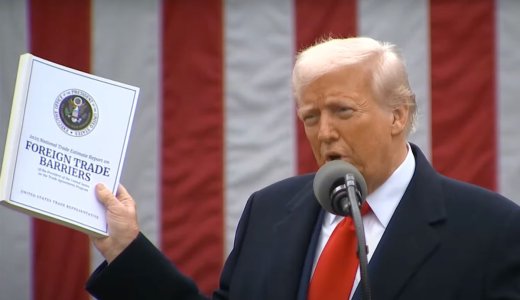"Liberation Day" shock: Discover the 2 surprising tariffs Trump just unveiled on April 2nd!
By
Veronica E.
- Replies 0
On April 2nd, President Donald Trump stirred significant attention with his announcement of two new tariffs, which he labeled "Liberation Day".
This bold move aims to reshape the nation's approach to international trade and economic policy.
However, while these tariffs have been presented as a way to level the playing field and strengthen the domestic economy, many are left wondering about the real impact on the everyday American citizen.
Will this policy shift lead to better job opportunities and lower costs in the long run, or will it result in higher prices for goods and services that families rely on?

The Tariff Tandem: A 10% Universal Duty and Reciprocal Tariffs
On April 2, President Trump announced two new tariffs, dubbing it "Liberation Day," aimed at addressing trade deficits between the US and its trading partners.
The new tariffs are:
Speaking from the White House Rose Garden, Trump described the day as "one of the most important days in American history; it's our declaration of economic independence."
However, economists warn that these tariffs could raise prices for US consumers, especially with inflation still high.
The first tariff is a blanket 10% tax on all imports, while the second involves reciprocal tariffs designed to balance trade imbalances with 60 countries.
Trump explained, "They do it to us, and we do it to them," adding, "It can't get any simpler than that."
As an example, Trump pointed out the US charges a 2.5% tariff on car imports, while the European Union imposes a 10% tariff on US car exports.
"Such horrendous imbalances have devastated our industrial base," he stated.
Also read: Trade tensions rise between US and Canada—tariff decisions pending
The Reciprocal Tariff: A Tit-for-Tat Trade Strategy
Reciprocal tariffs are Trump’s response to what he sees as unfair trade practices.
Currently, the US and its trading partners apply different tariffs on the same products.
For example, Germany imposes higher tariffs on US-made vehicles than the US charges on German imports.
Truly reciprocal tariffs would match the tax on US imports to what other countries charge on American exports, product by product.
However, by charging only 50% of the foreign tariff rates, Trump refers to this as "kind reciprocal" tariffs.
Trump also stated that the reciprocal tariffs would account for non-monetary trade barriers, such as when countries devalue their currencies to make their products more competitive.
Also read: Get the inside scoop: How these automakers are getting a Trump tariff break this month
The Timeline: When Will These Tariffs Take Effect?
The standard 10% tariff will take effect at 12:01 a.m. on April 5, while the reciprocal tariffs will begin at 12:01 a.m. on April 9.
The Rationale Behind Trump’s Tariff Tactics
In his announcement, Trump stated that the goal was to "revitalize the industrial and manufacturing base of the US" and that these tariffs would "make America wealthy again."
He believes the tariffs will encourage foreign businesses to relocate to the US and lower prices for Americans.
The Economic Forecast: Inflation and Higher Costs
Economic experts are raising concerns about potential inflation and higher costs.
A Goldman Sachs report suggests that the core personal consumption expenditures (PCE) price index may rise significantly by the year’s end, partly due to these new tariffs.
The report, which also takes into account previous tariffs, paints a more cautious picture than Trump’s optimistic view.
With inflation already slightly increasing in February, these additional tariffs could worsen the trend.
As members of The GrayVine community, it’s important to consider the broader effects of these economic policies.
Balancing economic growth with affordable living costs is a delicate challenge. Staying informed about these changes will help Americans understand how they may be affected.
Read next: Walmart’s price shock alert—what it means for your wallet

What do you think about Trump’s "Liberation Day" tariffs? Do you believe they’ll benefit the American economy, or are you concerned about their impact on prices and inflation? Share your thoughts and experiences in the comments below.
This bold move aims to reshape the nation's approach to international trade and economic policy.
However, while these tariffs have been presented as a way to level the playing field and strengthen the domestic economy, many are left wondering about the real impact on the everyday American citizen.
Will this policy shift lead to better job opportunities and lower costs in the long run, or will it result in higher prices for goods and services that families rely on?

"Liberation Day" Tariffs: President Trump announces new trade measures aimed at reshaping the US economy. Image Source: YouTube / PBS NewsHour.
The Tariff Tandem: A 10% Universal Duty and Reciprocal Tariffs
On April 2, President Trump announced two new tariffs, dubbing it "Liberation Day," aimed at addressing trade deficits between the US and its trading partners.
The new tariffs are:
- A 10% universal import duty on all goods entering the US
- Reciprocal tariffs targeting imports from 90 nations
Speaking from the White House Rose Garden, Trump described the day as "one of the most important days in American history; it's our declaration of economic independence."
However, economists warn that these tariffs could raise prices for US consumers, especially with inflation still high.
The first tariff is a blanket 10% tax on all imports, while the second involves reciprocal tariffs designed to balance trade imbalances with 60 countries.
Trump explained, "They do it to us, and we do it to them," adding, "It can't get any simpler than that."
As an example, Trump pointed out the US charges a 2.5% tariff on car imports, while the European Union imposes a 10% tariff on US car exports.
"Such horrendous imbalances have devastated our industrial base," he stated.
Also read: Trade tensions rise between US and Canada—tariff decisions pending
The Reciprocal Tariff: A Tit-for-Tat Trade Strategy
Reciprocal tariffs are Trump’s response to what he sees as unfair trade practices.
Currently, the US and its trading partners apply different tariffs on the same products.
For example, Germany imposes higher tariffs on US-made vehicles than the US charges on German imports.
Truly reciprocal tariffs would match the tax on US imports to what other countries charge on American exports, product by product.
However, by charging only 50% of the foreign tariff rates, Trump refers to this as "kind reciprocal" tariffs.
Trump also stated that the reciprocal tariffs would account for non-monetary trade barriers, such as when countries devalue their currencies to make their products more competitive.
Also read: Get the inside scoop: How these automakers are getting a Trump tariff break this month
The Timeline: When Will These Tariffs Take Effect?
The standard 10% tariff will take effect at 12:01 a.m. on April 5, while the reciprocal tariffs will begin at 12:01 a.m. on April 9.
The Rationale Behind Trump’s Tariff Tactics
In his announcement, Trump stated that the goal was to "revitalize the industrial and manufacturing base of the US" and that these tariffs would "make America wealthy again."
He believes the tariffs will encourage foreign businesses to relocate to the US and lower prices for Americans.
The Economic Forecast: Inflation and Higher Costs
Economic experts are raising concerns about potential inflation and higher costs.
A Goldman Sachs report suggests that the core personal consumption expenditures (PCE) price index may rise significantly by the year’s end, partly due to these new tariffs.
The report, which also takes into account previous tariffs, paints a more cautious picture than Trump’s optimistic view.
With inflation already slightly increasing in February, these additional tariffs could worsen the trend.
As members of The GrayVine community, it’s important to consider the broader effects of these economic policies.
Balancing economic growth with affordable living costs is a delicate challenge. Staying informed about these changes will help Americans understand how they may be affected.
Read next: Walmart’s price shock alert—what it means for your wallet
Key Takeaways
- President Trump has announced two new types of tariffs: a 10% universal import duty and reciprocal tariffs on imports from 60 nations, which he refers to as celebrating "Liberation Day" on April 2.
- The tariffs are aimed at reducing trade deficits between the US and its trading partners, while also revitalizing the American industrial and manufacturing base.
- Economists warn that the tariffs could lead to higher prices for many US consumer products at a time when inflation remains a concern.
- The 10% universal tariff is set to take effect at 12:01 a.m. on April 5, and the reciprocal tariffs at 12:01 a.m. on April 9, with the potential for the core PCE inflation measure to increase by 0.5 percentage points to 3.5% by year-end.
What do you think about Trump’s "Liberation Day" tariffs? Do you believe they’ll benefit the American economy, or are you concerned about their impact on prices and inflation? Share your thoughts and experiences in the comments below.






